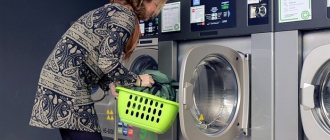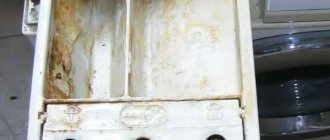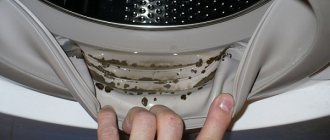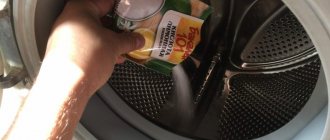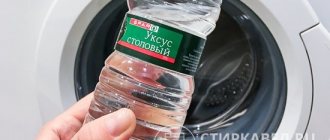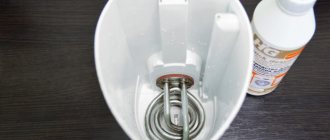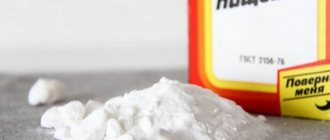Most modern housewives simply cannot imagine their lives without an automatic washing machine, which saves energy and time, greatly facilitating everyday household chores. However, not all of them know that a home assistant also needs regular care. And this should not be limited to wiping dust from the body, washing the detergent tray and adding anti-scale preparations. From time to time, much more extensive cleaning of the entire machine is required.
How to clean a washing machine
If this activity is not carried out periodically, the quality of washing clothes will decrease significantly over time, mold will appear on some parts of the appliance, and an unpleasant odor will begin to emanate from the drum. In order not to bring the situation to such a neglected state, it is necessary to regularly wash all the chambers of the machine.
Therefore, the question of how to clean a washing machine should be of interest to any owner. Moreover, in addition to the means offered by industry, there are more accessible, economical ways to restore proper order.
How to clean the drum
- Pour 100 ml of chlorine bleach into the machine drum and start the wash at a temperature of at least 60 °C. Without underwear, of course.
- You can use citric acid to remove scale. Pour 100 g into the drum and run the wash at maximum temperature. Ideally, the mode will include double rinsing. Then the plaque will be removed 100%.
- Mix a small amount of water and soda in a 1:1 ratio and pour the solution into the detergent compartment. Pour a little vinegar into the drum itself: no more than 400 ml. Set the temperature to maximum and let the machine do almost all the work for you. Then remove any remaining dirt with a sponge and wipe the drum dry. Plaque, mold and unpleasant odor will disappear without a trace.
Procedure for comprehensive cleaning
In addition to scale, there are other problems that can be caused by improper operation of the machine: dirt, unpleasant odor, mold. Therefore, you should regularly maintain the cleanliness of the internal elements.
Step #1 - wash the drum
After each wash, residual water and dirt remain in the drum. And soon black spots appear in the folds of the sealing cuff, and a musty smell comes from the depths of the machine.
Starting at idle speed with the addition of disinfectants or regular citric acid will help solve the odor issue. But the gum needs to be thoroughly cleaned by hand.
To clean the cuff, it is not recommended to use aggressive chemicals containing chlorine - such chemicals can make the rubber “hard” and quickly crack.
The easiest option is to carefully push the folds apart, wash the cuff around the circumference with a sponge, soap and warm water, and then wipe dry.
If you notice mold stains, you can use a solution of copper sulfate or prepare a cleaning paste of water and baking soda in equal proportions.
Then thoroughly treat the elastic band and the entire drum with this mixture, leave for a couple of hours, and then wipe with a sponge and start the long-term wash cycle.
For more information on cleaning your washing machine drum, see this article.
Step #2 - clean the filter and drain hose
The cause of an unpleasant odor can also be debris invisible to the eye - hair, particles of soil or building materials, lint, feathers and various small objects that were not removed from clothing pockets in time.
All this accumulates in the filter and hose through which the machine releases waste water. It is recommended to clean the washing machine drain filter at least once every 3 months, and more often during active use.
To do this, you need to remove the protective panel, place a small container for draining water or place a rag on the floor. Then unscrew counterclockwise and remove the filter. Rinse it under high pressure water and remove accumulated debris from the hole.
Typically the filter is located in one of the lower corners of the front of the panel and is covered with a small round or rectangular plate that can be easily pryed off with a flat-head screwdriver
To rinse the hose, you need to drain the remaining water in the machine through the drain filter and then disconnect it from the entrance to the sewer pipe or siphon. After this, you can remove the part, but exactly how to do this depends on the design of the device itself.
Ariston , Samsung , Indesit , Whirpool , Ardo machines you can only get to the hose connection through the bottom.
To do this, you need to lay the device on its side, remove the bottom panel and filter, and loosen the clamp with pliers. All that remains is to disconnect the pump and remove the hose itself.
Before disconnecting the hose, be sure to disconnect the device from the electrical network and turn off the water supply tap (if there is no separate one for the machine, then the apartment one)
In Electrolux and Zanussi you need to look for the drain fastening behind the rear panel, and in Bosch and Siemens - behind the front, when it comes to front-loading machines.
But for vertical models, you can only get to the hose through the side cover. Therefore, it will not be superfluous to check the instructions, which describe the device diagram.
To clean the drainage hose from dirt and powder deposits, equip yourself with a thin non-metallic cable with a mini brush attached to one end.
We run this brush inside, scroll it and gradually move it to the end of the hose. Then rinse under pressure of warm water. For severe contamination, several passes can be made.
Step #3 - wash the powder container
A rough coating from hard water appears on the walls of the detergent compartment, and traces of powder and various rinse aids remain. All this needs to be removed.
If the remnants of detergents are quite easily removed with warm water and a sponge, then limescale or mold will have to be fought
We act in stages:
- We remove the cuvette from the compartment and remove the container for the conditioner.
- We rinse under running water, wipe off mold stains with soda or any chlorine-containing product (there are no rubber elements here, so chlorine will not harm).
- Pour a packet of citric acid into a small bowl.
- Place the disassembled cuvette, fill it with hot water and leave for an hour (if it is heavily soiled, it can be overnight).
- Then we remove the remaining plaque with a sponge and thoroughly clean all joints with a toothbrush.
- Dry the container, assemble and place in place.
Another option for dealing with plaque is to fill the removed cuvette with soda and add table vinegar. As a result of the reaction, the soda will foam and soften the lime deposits so that they are easier to remove.
In addition to the container itself, the powder receptacle itself also requires cleaning, and there are many hard-to-reach places with various recesses and small parts
To get rid of dirt and plaque in the container compartment, you can use the same soda paste and toothbrush, and pre-treating the tray with a spray cleaner will help speed up the process.
How to descale heating elements
- Citric acid will again help get rid of scale on the electric heater. The amount of powder depends on the degree of soiling, but on average, a machine with a 5 kg load requires 250 g. Pour 200 g into the powder compartment, and 50 into the drum and run the wash at maximum temperature.
- More aggressive acetic acid can also deal with scale. Just add 50 ml of vinegar to the conditioner container and turn on the machine. Be careful: vinegar can damage the rubber elements.
Care and prevention
- the correct location of a household appliance involves installing the machine on a flat horizontal surface, without twisting the electrical cable and hoses;
- there should be no foreign objects on the top panel of the unit;
- Wipe the external parts of the device with a damp sponge at least 2 times a month, followed by a dry cloth;
- after every 3-4 washes, rinse the compartment for powder and liquid products with running water;
- to avoid damage to the drum and appliance door by metal fittings present on items, turn clothes inside out before washing or place them in special mesh bags;
- Do not overload the unit with laundry: excess weight can lead to rapid wear of the motor.
Maintaining the functionality of the washing machine for a long time requires regular care of each element of the device.
The use of chemicals and improvised means, special washing powders containing water softening substances will prevent the appearance of scale and damage to household appliances.
How to Clean a Drain Hose
When you clean the drum with baking soda and vinegar, the drain hose is also cleaned. But if a serious blockage occurs, additional measures must be taken.
Unplug the washing machine and turn off the water supply. Disconnect the hose from the machine (water may spill out during the process, so do not forget to substitute a container).
Now you can start cleaning. For it they use a Kevlar cable with a non-metallic (!) brush at the end. First clean the hose on one side, then the other, and finally rinse it under running hot water.
Preventing precipitation
The use of special water softeners will help prevent the appearance of sediment on the internal parts of the device:
- Magnetic and electromagnetic type - as a result of the operation of the devices, hardness salts lose their ability to connect with each other and accumulate on the surface of the heating element and drum. Softeners are installed at the entrance of the water supply to the house or on the inlet hose of the machine. The main disadvantage of the method is the high cost of magnetic devices.
- Installing sediment filters on the water supply pipeline to the apartment will help prevent damage to the unit as a result of sand and rust particles getting into it.
When washing, try to use the machine’s operating mode, which involves heating the water to a temperature of less than 80 ⁰C: this will prevent the acceleration of the precipitation of hardness salts.
How to Clean a Top Loading Washing Machine
Cleaning is carried out at the highest temperature. First, pour 2-3 cups of vinegar into the water and let the machine stir the solution for a couple of minutes.
Then add half a cup of baking soda. Allow the ingredients to react, then turn off the appliance and leave it to soak. This will take from 30 minutes to an hour.
While the insides of the machine are being cleaned, take care of the rest of its parts. Mix vinegar and water in a 1:1 ratio and wipe the surface of the device with the solution, clean the powder compartment.
When the machine gets wet, resume washing. Wait until all the water has drained and use a sponge to remove any remaining dirt.
Mechanical impact
Manual cleaning of the heating element is also an effective procedure for removing hardness deposits, but the method requires disassembling the household appliance and having certain knowledge and skills.
Cleaning process:
- disconnect the wires, sensor, remove the tubular element;
- rinse the heating element under the pressure of hot water, remove the top, loose layer of dirt with a hard sponge;
- cut off the neck of a plastic bottle, pour 4 tablespoons of citric acid into it and place a heating element in the container, fill it with hot water to the level of the stop bar;
- shake the bottle several times and leave it for 8-10 hours;
- After the time has passed, remove the part and rinse it with water, while simultaneously cleaning the surfaces with a soft sponge from any remaining deposits.
IMPORTANT!
It is unacceptable to remove solid sediment from the part with a file, sandpaper, or knife - metal objects can damage the surface of the heating element.
Traditional recipes or special remedies?
FolkSpecial
Recommendations for caring for your washing machine
To keep your car clean for as long as possible, try to follow these tips:
- Don't use too much powder. Excess detergent may accumulate inside the machine.
- Remove heavy soiling from clothing before washing.
- Use special anti-scale products.
- Leave the door open after washing. This will reduce the risk of fungus formation.
- From time to time, run the empty machine at maximum temperature. Hot water itself does a good job of removing minor stains.
Do you know other ways to easily clean your washing machine? Share them in the comments.
Causes of pollution and their possible consequences
First, let’s make sure that cleaning is a forced and necessary action. And it doesn’t hurt to know what exactly needs to be cleaned. Let's take a look inside the machine, which has worked for quite a long time. It is highly likely that we will see a dirty coating on the surface of plastic and metal parts. It can be hard and contain minerals, so you can’t handle it with a rag or your hands.
The reasons for this problem may be the following:
The water coming from the tap is hard or dirty.
The powder contains too many chemical components.
The machine constantly operates in the “intensive wash” mode.
What’s especially bad is that many of the corners where dirt accumulates are difficult to reach. Try to clean them - your hand won’t fit there, and poking with something sharp is too dangerous. So more and more dirt accumulates, and then the machine can’t stand it and breaks down. And repairs cost a pretty penny. So why go to such extremes - it’s better to ask in advance how to clean the drum of the washing machine, its tank and heating element. By taking timely measures, you can significantly extend the life of the device.
Why does scale form?
When water is too hard, it is full of calcium and magnesium salts. When heated, they are converted into carbon dioxide and solid sediment, which, together with dirty particles (for example, pieces of rust), remains on the heating element and the tank of the washing machine. When covered with a crust of scale, the metal heating element conducts heat worse. Result: water takes longer to heat up, more electricity is required. And dirt from the water also does its dirty work - it clogs the inlet valve, the parts of which wear out ahead of time.
Important: maximum dirt and debris penetrates into the machine after repairs or turning off the water.
You can find out whether there is scale on the heating element or not yourself. Usually the heating element is located directly under the drum, or is slightly offset relative to its center to one side. Taking a flashlight, direct its beam at the holes in the drum, trying to see the heating element. At the same time, shake the drum slightly so that the lighting is uniform. Often this is not possible right away - you have to experiment a little with the speed of swinging.
Washing machine heating element with huge salt deposits.
An unconventional method of descaling using a magnetic field
Treatment of water with a magnetic field is an unconventional type of anti-scale treatment. This is a simple, cheap, environmentally friendly method with low operating costs. Water treated with a magnetic field does not acquire any side effects or properties harmful to life and health, and retains its taste. Its salt composition also does not change. The magnet only transforms water, activates it and, through its activation, helps prevent the appearance of scale.
The first magnetic processing devices were tested about 40 years ago and confirmed their safety in practice. Magnetic devices do not affect the softness or hardness of water, nor its salt composition and taste, but have a selective effect - they prevent the deposition of salts on the heating elements of devices. Good protection is provided.
Why is it important to fight scale?
Is periodic cleaning of washing equipment really necessary? The fact is that most of the pollution is hidden from view, but the consequences of their accumulation will not take long to appear:
- dirt and scale harm the heater, reducing its efficiency and also contributing to rapid wear of parts;
- the water in the machine does not heat up well;
- electricity consumption increases;
- laundry does not become cleaner when washed and acquires an unpleasant odor;
- Particles of scale, dirt and rust clog the drain pump filter, as a result of which water does not drain from the machine
- equipment stops working, requiring parts to be replaced.
If things get serious and the machine refuses to wash, you have to call a technician. It is not difficult to guess that changing the heating element requires serious expenses. But timely measures will save your wallet and significantly extend the life of the device. At the same time, it is not necessary to buy a professional anti-scale agent for washing machines - any housewife will find suitable products at home.
Mechanical method of removing lime deposits
It should be noted that the use of this method is the most labor-intensive. To carry out mechanical cleaning, the heating element must be removed from the machine. Armed with sandpaper, rags and gloves, carefully clean off all plaque, trying not to scratch the electric heater. Extreme caution should be exercised and do not use sharp tools when disassembling and assembling the device mechanism. Not only the heating element is cleaned, but also the detergent receiver pipe, the garbage filter, the pump, the drain and water fill hoses.
Error codes and malfunctions of the Ariston washing machine
With a special tool and certain skills and knowledge, you can do without the services of a specialist by performing the cleaning procedure yourself. You just need to remember the rule of this cleaning - after removing and cleaning the part, do not forget to put it back in place and securely fasten it.
This method has features:
- It is cheap because it does not require special devices or means for the cleaning process;
- The heating element is cleaned outside the machine, the quality of the procedure increases because the separated pieces of scale remain outside and cannot cause harm by clogging the unit from the inside, as happens during chemical cleaning;
- If you soak this part after mechanical treatment in a container with citric acid, then, after wiping it well, remove the smallest particles of scale, then when cleaned in this way, its condition, without special costs, as a rule, becomes perfectly cleaned.
- A positive additional result of such processing will also be checking the condition of internal parts, which makes it possible to determine their wear and prevent malfunctions.
How to properly use chemical cleaners
For the safe use of chemicals in household processes, certain requirements and conditions must be met. This rule also applies to cleaning lime deposits from washing machines. A few tips will help you complete the procedure without harming the health of others and ensure environmental safety of the cleaning procedure.
Carefully read the instructions for use of a particular chemical product and strictly follow it.
Regardless of the choice of chemical, it is mandatory to fulfill the general requirements for the cleaning procedure of an automatic device:
- cleaning is carried out without loading laundry, with the machine idling;
- the temperature regime is maintained within 30-90;
- when cleaning the heating element and drum, the product can be placed directly into the drum or into the washing powder compartment before starting the cleaning session;
- working with all chemicals requires the use of latex gloves to avoid burn injuries to the hands;
- when carrying out treatment, you should turn on forced ventilation, if it is available in the apartment;
- All rooms are well ventilated after working with chemicals.
The frequency of use of the product and the amount of substance used in one cleaning depend on its concentration: highly concentrated preparations are used less frequently and in small quantities.
When carrying out the cleaning process, preference should be given to liquid preparations; they dissolve more easily in cold water and are more effective in affecting deposits and any contaminants.
Consequences
Scale causes breakdowns of evaporators, water heaters, steam boiler pipes, tubular electric heaters for kettles, dishwashers and washing machines, and is the root cause of failure of household appliances.
The most likely cause of a problem with an automatic washing machine, when it suddenly turns off, perhaps even in washing mode, is a breakdown of the tubular electric heater (heating element). On this part, as already noted, due to the effects of the presence of salts and metals in the water, scale accumulates. Its negative impact begins already from the first wash, although the machine is still working, it would seem, without deviations.
Scale is a very dangerous enemy of heating equipment. It reduces thermal conductivity, increases energy costs, and can intensify corrosion of metal parts. If you do not take special measures, the device will completely fail.
To prevent the enemy from showing its destructive effect, you need to either wash in soft water, or use special substances to neutralize water hardness. Even a thin layer of deposits, the appearance of which is provoked from the first turn on of the machine, can initially create very little interference with heating the water: the heating process will require a little more time, which leads to a gradual increase in energy costs with each wash and an increase in salt deposits. In addition, the high temperature required for washing clothes activates the formation of scale.
When the amount of deposits becomes critical, the housewife's irreplaceable assistant is unable to provide its main function. The washing machine breaks down and may turn off even in operating mode. More significant financial investments will be required to either replace or repair a unit affected by scale deposits.
Another initially hidden negative impact of scale is the appearance of fungus, the destruction of which is difficult and financially costly for the consumer.
Traditional methods of cleaning a car
How to clean a washing machine with citric acid
Citric acid is used for light stains, unpleasant odors in the car, and also as a preventive measure for heating element scale and for cleaning the drum. At the same time, if you compare it with expensive purchased products and read the composition, you will see that 75% of the product consists of acid. When compared, the benefits are obvious.
The procedure for cleaning the machine with citric acid:
- 50-100 grams of lemons are placed in a powder tray
- Select the longest washing mode and the highest temperature of 90 degrees
- After finishing the wash, set the machine again for an additional rinse.
If there is still a smell after cleaning, don’t despair. There is an explanation for this:
- You haven’t cleaned your washer for a very long time and after running it, all the plaque hasn’t been removed.
- With constant washing at 40 degrees, bacteria and fungus spread on the walls and it is already difficult to get rid of it
In such cases, repeat the cleaning procedure. After this, wipe the car dry and dry it with the hatch and tray open.
Remember! This is prevention. And it is advisable to use this method no more than once every 6 months.
How to Clean a Washing Machine Using Baking Soda
Soda helps get rid of mold, because when dissolved it creates an alkaline environment, which fungus does not like so much. Most often it is distributed on the sealing rubber, in the drum itself, in the powder tray.
Mode of application:
- Make a paste: half a glass of water and half a glass of soda, mix well to obtain a homogeneous mass.
- Apply a little paste to a sponge and wipe the affected area thoroughly. Try to use rubber gloves during the procedure
- Leave for a while and wipe with a damp cloth
- Turn the machine on to rinse mode
If you take citric acid and soda, you can partially get rid of scale, if the contamination is not severe6
- Take 150 g of citric acid and 2-4 teaspoons of baking soda
- Pour this mixture into the powder tray
- Turn the washing machine on the longest cycle at the highest temperature. When finished, repeat the rinse cycle again.
How to use vinegar when cleaning
Vinegar is used less frequently, but it can also be used for mildew or mildew.
- Pour 9% vinegar into the tray for liquid laundry detergent - 2 cups
- We start the machine at high temperature and select the longest washing mode
- After 10-15 minutes have passed, turn off the washing machine for a couple of hours in order to kill the fungus
- Next, continue washing and additionally set to rinse mode after stopping
- Wipe the entire interior surface and rubber seal with a soft cloth dampened with vinegar solution.
- Wipe the machine dry with a dry cloth and leave to dry with the hatch and tray open.
Interesting! Some housewives add 1-2 tablespoons during washing to soften the water and prevent scale. And if you add apple cider vinegar, you can get a pleasant smell for your laundry.
Cleaning the washing machine with bleach
Bleach, also known as Whiteness, helps fight mold and disinfect the most inaccessible places.
How to properly use bleach when cleaning:
- Pour 100 ml of white directly into the washing machine (drum)
- Turn on the mode with a temperature of 90 degrees for 30-40 minutes
- Then run an extra rinse
Use Whiteness no more than once every six months. When using Domestos, be careful - it tends to foam.
The best chemicals for cleaning automatic machines
If you still trust store-bought products more, then it is better to buy specialized drugs sold in specialized stores. The most purchased and popular ratings among users:
- Topperr 3004 (Germany) – suitable for descaling dishwashers and washing machines. Recommended by Bosh manufacturers.
- Schnell Entkalker (Germany) - quickly helps to get rid of lime deposits on internal elements.
- Antikalk for Washing Machines from Sano (Israel) is a universal gel for the prevention and elimination of small plaque with an antibacterial effect.
- Magic Power (Germany) is one of the best specialized products for washing machines. Available in the form of gel and powder, which effectively removes plaque from heating elements, tanks, and drums.
- Beckmann (Germany) is a universal product that will protect against scale and eliminate unpleasant odors caused by various contaminants. But, like any multi-purpose product, it is good for regular care, but will be ineffective against heavy dirt.
- Filtero 601 (Germany) – works well to remove old scale from the heater and other elements; it is recommended to use 3-4 times a year for intensive cleaning of the machine. Available in 200 g bags for one use.
- Doctor TEN (Russia) and Antiscale (Belarus) are inexpensive drugs that help remove scale from any heating elements.
- Bork K8P1 (Korea) – will clean scale. In stores it is sold in a package of 4 sachets.
- Shumanit Bagi (Israel) – gets rid of scale, limescale, and rust. Cleans surfaces well.
All these products are available in convenient packages in the form of powder or liquid products. I usually buy liquid products that contain bleach, which helps get rid of limescale and mildew.
These products also clean other appliances: irons, dishwashers, etc.
Water softening through filtration and purification systems
An important tip for the longevity of household appliances is water softening. To neutralize the formation of magnesium and calcium deposits and to reduce the concentration of their salts in water, install special filters and systems for purifying tap water. Industrially, such cleaning is carried out by water utility services, but the quality of water after such large-scale actions is far from the desired indicators. Before water comes into the apartment, it comes into contact with many sources of contamination from pipes. To solve the cleaning issue, experts recommend installing water converters, filters that soften water directly in the drainpipe or are inserted into the hose at the inlet of the device.
Mechanical cleaning using filters with cartridges effectively removes rust, dirt, and sand. An ion exchange filter, for example, is installed in a pipe at the water inlet to an electrical appliance. This type of flow filter retains water hardness by converting the constituent scale salts (calcium, magnesium, etc.) into sodium ions. Already softened water enters the machine. A dirty filter cartridge can be easily restored by placing it in a water-salt solution. A flow filter with timely and high-quality cleaning will provide a long service life for the electrical appliance, cleaner laundry with economical use of detergents, and a reduction in energy consumption for the washing cycle. The financial benefits are obvious.
Reasons for appearance
Water, no matter how clear it looks, contains impurities and salts. Tap water, even if it undergoes industrial purification methods, cannot be completely purified from various additives, salts, and impurities. The presence of such substances to a greater or lesser extent in water indicates its hardness.
This quality - water hardness - is the cause of many problems. When heated, the impurities contained in water decompose into two elements: a precipitate of metal salts and carbon dioxide. The sediment does not dissolve; it has the negative ability to be deposited on the walls of the heating device and the vessel in which the water is located. These solid deposits that form on appliances and containers when water is heated or evaporated are called scale. Water with a high content of calcium and magnesium forms the most scale; it is considered to be the hardest.
This article is devoted to the problems of automatic washing machines, which directly depend on the appearance of scale in them, and to the prevention of these consequences.
Causes of unpleasant odor
The stench occurs for various reasons. Therefore, before you clean your washing machine from a putrid odor, you need to find its source. The culprits are usually:
Mold and mildew
They will definitely appear if you wash frequently at temperatures below 40°C. Cool water does not remove pathogenic microorganisms. Left inside the machine, they quickly multiply in a warm and humid environment, and then end up on things, making themselves felt with an unpleasant odor.
Mold is especially likely to form in front-loading machines because they use less water than top-loading machines. This means that after rinsing, microorganisms remain in place. Mustiness also appears when the sunroof seal is not wiped off.
Problem with sewer lines
If, despite regular cleaning, the machine produces a stench, then the problem is caused by poor sewerage. In this case, you will have to start replacing the pipes. And if repairs are not expected, then correct installation of the drain hose will help block the smell from entering the machine.
It should rise above the floor by at least 50 cm, and be in the shape of a U. This position will be ensured by a shutter that will block the passage of stench into the machine.
Clogged hose
Washable dirt and powder often settle on its walls. If the hose is not cleaned, then the resulting deposit will begin to rot, becoming a source of stench. To eliminate the musty smell, you will need to flush the hose or replace it.
Drain filter clogged
The device traps debris, preventing it from entering the sewer. Over time, it becomes clogged with soaked paper, hair, lint, and animal hair, turning into a rotting swamp.
The drain filter must be cleaned at least every six months, and sometimes more often.
Contamination of the tray and flush channel
Limescale deposits, washing powder residues, lack of ventilation and drying - all this contributes to the appearance of mold. Experts recommend rinsing the tray every three washes and cleaning the channel with a small brush.
Scale
Formed due to hard water, as well as drying out of detergent residues. Moreover, the higher the temperature, the faster the process of scale formation will be. TEN especially suffers from it. When it turns on, the layers burn, emitting “that same” smell.
Detergent and its dosage
To completely wash off the powder, you need a certain amount of water. If there is too much of it, the washer will not cope. The product remaining on the walls will accelerate the appearance of an unpleasant odor.
